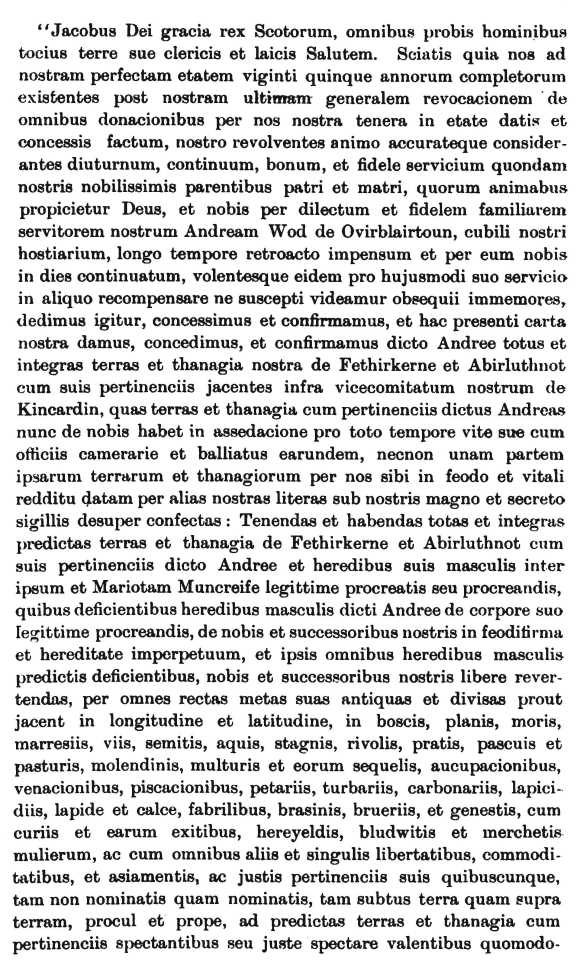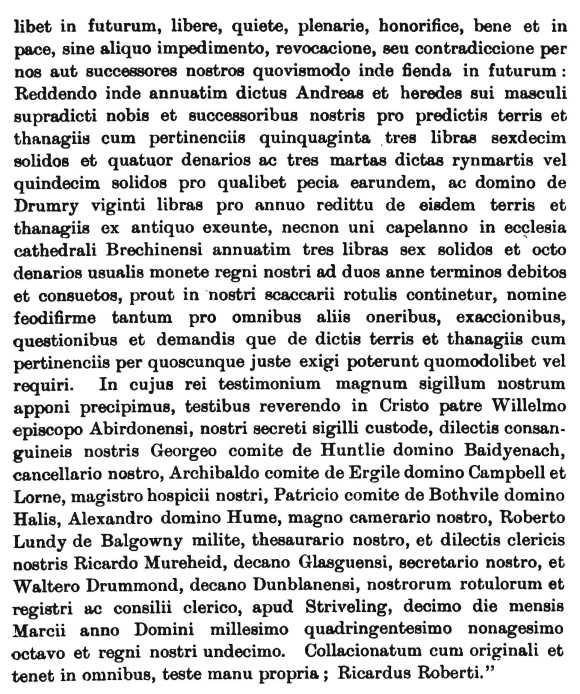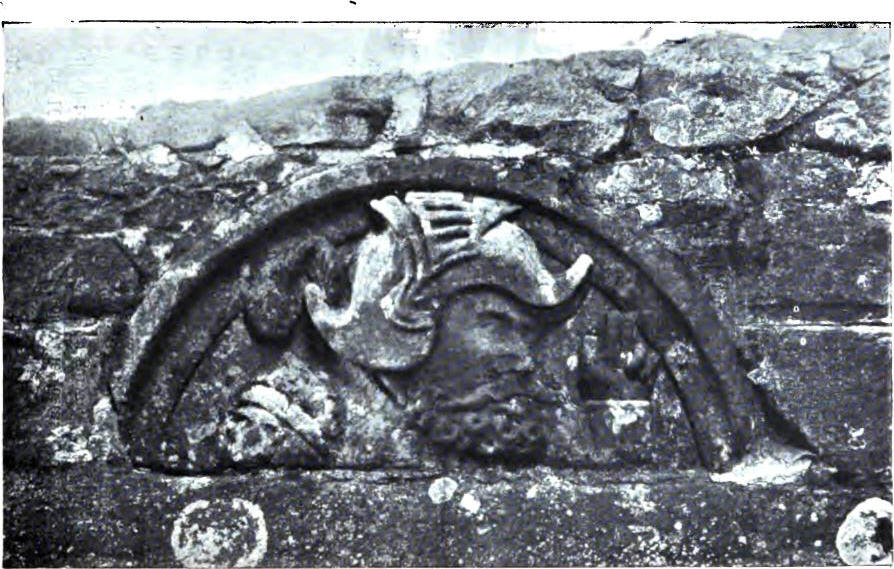THERE has been given in a
previous chapter some account of the ownership of Balbegno at different
periods down to 1488, so far as it is ascertainable. After that date the
feudal owners of the same and of other contiguous lands were Andrew Wood and
his successors. They were also thanes of Fettercairn, with arbitrary power
•over their vassals and all within their domain. They could fine, scourge,
imprison, and even put to death without appeal to common law. The particular
places where these powers were carried out will be described in connection
with Balbegno Castle.
The family of Wood,
originally De Bosco, was probably of Norman origin. Several of its members
were eminent churchmen. William de Bosco acted as clerk to King William the
Lion (1165-1214) in his courts at Forfar, Kinghorn, and Selkirk. This
William was Chancellor of Scotland and Bishop of Dunblane. About 1240 Ralph
de Bosco was Bishop of Aberdeen, and confirmed a grant of the Church of
Aboyne to the Knights Templars. Towards the end of the thirteenth century
the De Boscos gained a footing in the north of Scotland. In course of time
the name was changed to Wod or Wood, and among other owners of lands in the
county of Aberdeen appears the name of Andrew Wod of Overblairton, Belhelvie,
in the reign of James III. A grant of the Castlehill and Stocket wood of
Aberdeen was made to him by that king; but this grant, being contrary to
Robert the Brace's Charter to Aberdeen, was revoked by James
IV. After the battle of Sauchie near Stirling,
fought on 18th June, 1488, when James III. was killed, James
IV. became king. On the 26th of the same month, at
Perth, a grant of the lands of Balbegno and of the thanages of Fettercairn
and Aberluthnot was made to "Andro Wod of Overblairton, Belhelvie, and his
spouse Mariota Moncreife." His designations were Camerarius, Ballivus, and
Receptor, or Chamberlain, Baillie, and Receiver of the king's rents from the
said thanages and from other crown lands in the county of Aberdeen. James
IV. treated Perkin Warbeck, the pretended Duke of
York and claimant of the English throne, as his guest, and laid a tax on the
country for his support. Andrew Wood was collector of this tax for the part
north of the Forth, and was paid certain sums of money for his labours. The
annual rent of Balbegnoth was twenty merks. The lands of Easter Strath and
the Barony of Balmane, which by reason of non-entry had been for twenty-six
years in the king's hands, were granted to "his familiar servitor Andro Wod."
This allocation continued till 1510, when the lands and Barony were granted
to John Ramsay. In the Burgh Records of Stirling, the following entry
appears, viz.: "March 18th, 1503. Oure sovrane lord ratifyt and approvit ye
charter of confirmation and gift maid to Andro Wod ischar of ye chaumer door
of ye feu of ye lands and thanedom of ffethirkern and Abirluthnot after ye
form of his infeftment maid to him thereuppon." His fee as usher was .£13
6s. 8d.
The charter of confirmation
above referred to was granted in 1498. Although a lengthy document and
written in Latin, it is, for its minute and interesting details, worthy of a
place here, as follows:—


A translation of the above
made by an eminent Latin scholar, A. F. Hutchison, M.A., late of the High
School of Stirling, is as follows :—
"James, by the grace of God,
King of Scots, to all good men of his whole land, cleric and laic, Greeting:
Know ye, because we being at our perfect of twenty-five years complete,
after our last general revocation of all donations given and granted by us
in our tender age, for the long, continued, good and faithful service done
to our umquhil most noble parents our father and our mother—for whose souls
may God provide—and to us by our bektred and faithful familiar servitor
Andrew Wod of OvirbUir-ts/nn hsMtiarixm. of oar chamber for a long tune
bypast. and continued by him to us from day to day. and willing to
recompense the Ğa*ne for his service of this sort, that we may not seem
forgetful of the doty undertaken.—therefore we have given, granted and
confirmed, and by this oar present writing give, grant and confirm to the
said Andrew all and whole our land^ and thanages of Fethirkerne and
Abirlathnot with their pertinents. lying within oar sheriffdom of Kincardin,
which lands and thanages with their pertinents the said Andrew now holds of
us in tack (or assedationj for the whole time of his life with the offices
of chamberlain and baillie of the same, besides one part of the same land*
and thanages given by us to him in feu and at a victual rent* given by oar
other letters made (complete) before under oar great and privy seals: to be
had and held all and whole the foresaid land* and thanages of Fethirkerne
and Abirlathnot with their pertinent* by the said Andrew and his heirs male
lawfully begotten or to be begotten between him and Mariota Muncreif, whom
failing, by the heirs male of the said Andrew to be lawfully begotten of his
own body, of as and our successors in feufirm and hereditarily for ever, and
all these heirs male foresaid failing to return to us and our successors, in
all their proper ancient metes and divisions, as they lie in length and
breadth, in woods, plains, moors, mosses, roads, paths, waters, lakes,
burns, meadows, grass-land* and pastures, mills, multures and their sequels,
fowlings, huntings, fishings, peats, turfs, coalpits, quarries, stone and
lime, workshop, breweries, heaths and broom, with courts and their profits,
heregelds, bludewits and taxes payable on the marriage of female vassals,
and with all other and singular liberties, commodities and easements and
their just pertinents whatsoever, named and unnamed, both under the earth
and above the earth, far and near, belonging or that in the future may in
any manner justly belong to the foresaid lands and thanages with their
pertinents, freely, quietly, fully, honourably, well and in peace, without
any impediment, revocation or contradiction to be made in any manner by us
or our successors in the future: the said Andrew and his above-said heirs
male paying yearly to us and our successors for the foresaid lands and
thanages with their pertinents 53 pounds 16 shillings and 4 pence, and three
marts called rynmartiH or 15 shillings for each piece {i.e. each mart) of
the same, and to the laird of Drumry 20 pounds as annual rent from the same
lands and thanages according to the ancient exit, as also to a chaplain in
the cathedral church of Brechin yearly £3 6s. 8d. usual money of our realm,
at the two usual and customary terms of the year, as is contained in the
rolls of our exchequer, in the name of feufirm only, for all other burdens,
exactions, questions and demands which can in any way justly be exacted or
required by whomsoever from the said lands and thanages with their
pertinents.
"In testimony of which we
order our great seal to be appended : Witnesses, the reverend father in
Christ William, bishop of Aberdeen, keeper of our privy seal; our beloved
cousins—George, Earl of Huntly ; Lord Badenoch, our Chancellor ; Archibald,
Earl of Argyle; Lord Campbell of Lorn, master of our hospices; Patrick, Earl
of Both well; Lord Hailes; Alexander, Lord Hume, our great Chamberlain ;.
Robert Lundy of Balgowny, Knight, our treasurer; and our beloved
clerks—Richard Muirhead, dean of Glasgow, our secretary ; and Walter
Drummorid, dean of Dunblane, clerk of our rolls and register and of the
council, at Stirling on the 10th day of the month of March, in the year of
our Lord, 1498, and the 11th of our reign.
"Compared with the original,
and correct in all. Witness my hand; Richard (son of) Robert (Robertson?)"
These old writings, now
collated and brought to light, clearly prove that Andrew Wood of Fettercairn
was not, as supposed and stated by some, the famous Admiral Sir Andrew Wood
of Largo. They were contemporaries, and probably related as cousins, for the
same christian names, Andrew, John, and Walter, are those of both families.
The carved figures on Balbegno Castle give colour to this supposition. One
of these, a male bust, with the left hand erect, three fingers extended, the
face bearded, and the head with cap and morion, is now placed over the
garden door, and may represent Admiral Wood in the attitude of a naval
commander. The sculpture probably commemorates the great fight in the Firth
of Forth, where Sir Andrew and his brothers with two ships captured the
three which the English king had sent to make an end of the Scots power at
sea. The trinity went down before the two on the left hand.
About 1512 Andrew Wood of
Balbegno was succeeded by his son John, a minor, for whom, till 1518, his
uncle, Robert Moncrieff of Curroqhuy, near Crieff, acted as tutor, and then
a William Gordon, sponsus matris (his stepfather), assumed the duty. David
Wood of Craig and a brother William Wood of Bonnington lived about the same
time, and were related to John Wood. The sasine granted to him by James
IV. in 1512 runs thus:—"The thanages of
Fethircarne, Abirludnocht, Balbegnoth, Ballarno, Balnakadle, Fotheray,
Thaneston, Molendini Perichcroft, Balmakewin, Molendini de Luther, Drumry,
Officii Strath-auchin de Thorn toun, Brodland, Kirkton, and Wester Strath."
His wife was Elizabeth, daughter of Sir Alexander Irvine of Drum. Balbegno
Castle was built by them. Their son Walter succeeded in 1579, and married
Helen Stewart, daughter of John, third Earl of Athole, whose
great-grandfather was Sir James Stewart, " the black knight of Lorn," who
married Joanna, the widow of James I. of Scotland. This gave the descendants
of Walter Wood and Helen Stewart a connection with royalty. They had four
sons, viz.:—Walter, Andrew, David and William. Walter succeeded in 1598, and
after him, in 1607, came his son, designated Sir John Wood. To him a brother
James was served heir in 1636, whose son Andrew succeeded in 1656. His
infeftment, by precept of Oliver Cromwell, confirmed to him.

"The Manor place and Mylne of
Balbegno, the lands of Balerno and astricted multures, Caldcoats, utherwayes
called Tillifonten, Bonaketill and Strathnosen, Skairruids, the lands of
Fetterkairn, the croft besyde the Nethermylne, the mylne of Blackelauche, (Boggindollo),
with the office of chamberlanrie and bailyiarie of the said lands, the lands
of Strathester, with liberty in the Mure of Luther, and Moss of Balmayne,
and power of pasturage of nolt and sheep, all united into the barony or
thanage of and within the parochin of Fetterkairn. Entry, £12 13s. 4d."
In 1687 Andrew Wood sold the
estate to Andrew Middleton of Caldhame and Pitgarvie, the youngest brother
of John Earl Middleton. Andrew Wood married a daughter of Sir Alexander
Strachan of Thornton, and their son, Major James Wood, residing at
Invereskandye, was factor to Lindsay of Edzell, and an elder of the church
at Edzell. His wife was Margaret Jackson, and their daughter Jean married
John Lindsay of Dalbog. Major Wood's great-great-grandson was the late John
Wood, banker, Colinsburgh, wTho died in 1875, leaving a large family, one of
whom, John, an eminent artist, resides at Bramerton Lodge, Carlisle. To him
and to his wife now deceasedt whose efforts and correspondence in tracing
the genealogy of the Wood family were unwearied, the writer has been much
indebted. The name of Wood became a leading one in the parish of Fettercairn,
and continued to be so down to the beginning of the present century. Andrew
Middleton got the lands of Caldhame and Pitgarvie by his marriage with
Elizabeth, daughter of Sir Charles Ramsay of Balmain. From a minute of
Presbytery in 1683, he appears, some four years before his purchase of
Balbegno, as an heritor of the parish and an office-bearer in the church,
with the oversight of Earl Middleton's lands. After his death in 1699, his
son Robert became proprietor of Balbegno, and married a daughter of George
Ogilvy of Lunan. He died without issue in 1710, and bequeathed the property
to his brother-in-law, John Ogilvy, advocate, who died in 1743, and by his
wife Isabel Cochrane had four daughters, the eldest of whom, Girzel, married
a Dr. Brisbane, and after her mother's death, in 1756, possessed the estate
till 1778, when it was sold to the Hon. Walter Ogilvy of Clova for the sum
of £7500. In 1819 his son, the Hon. Donald Ogilvy, succeeded, and, in 1846,
sold Balbegno to Sir John Gladstone for £32,000.
BALNAKETTLE AND LITTLESTRATH.
It was said that the cost of
building Balbegno Castle impoverished the Wood proprietors and became a
burden on the estate. Also, that Balnakettle and Littlestrath had to be sold
to pay the debt. The former at least was not finally disposed of till the
time of Andrew, the last of the Woods. In 1678, a retour of Balnakettle was
made to "William Fraser, Merchant in Dundee, brother of Andrew Fraser of
Balnakettle." Again, in 1682, another retour appears in favour of Mr Robert
Reid, son and heir of the
Rev. Robert Reid, minister of
Banchory Ternan, for the "lands and dominical lands of Balnakettle, the
plough land of Garden Plough, lands of Strathnossen, Skair, and manor place
of Balnakettle in the Barony of Balmain, &c." The Rev. Robert Reid of
Birnies and Balnakettle was a grandson of Robert Reid, also minister of
Banchory Ternan, who succeeded his father, James Reid, the first Protestant
minister of that parish after the Reformation. James Reid had other
distinguished sons: Thomas, Greek and Latin secretary to James
VI.; Alexander, physician to Charles I., who left
a large bequest to his native parish; James, a surgeon and an fcminent Latin
scholar; Adam, minister of Methlick; and three daughters. The Rev. Robert
Reid of Balnakettle had two sons: Robert of Balnakettle, and Thomas, who
married Jane Burnett of the House of Leys. One of their sons was Robert,
minister of Banchory, and another, Lewis, minister of Strachan, of whose
first family was Thomas Reid, D.D. (1710-96), the famous Moral Philosopher.
Margaret, a daughter in the second family, married in 1763 the Rev.
Alexander Leslie (a descendant of the House of Rothes), minister of Durris
and afterwards of Fordoun. They had seven sons and four daughters. Their
eldest son was the much respected Dr. James Leslie, minister of Fordoun, who
died in 1858 at Stonehaven, in his ninety-fifth year. Their fourth and only
married son, Alexander, had by his wife Jane, daughter of Sir William Seton,
Bart, of Pitmedden, a sou Alexander Leslie of Birkwood, Banchory Ternan, who
had by his wife Johanna, daughter of George Hogarth of Woodhill, three sons
and two daughters, and died in 1862. The younger daughter is Grace-Anna
Leslie of Birkwood, who married Alexander R. Paterson, M.D., M.R.C.P. Of
their family of two sons and two daughters, the youngest is Hilda-Maud
Paterson, who favoured the author with Sir Walter Scott's letter, which will
appear in chap xix.
So far as is known the next
owner of Balnakettle, whether by heirship or purchase, was William Strachan,
son of Charles Strachan of Balgays. In a Presbytery Minute of 1702 he
appears as heritor of. Balnakettle, and in another of 1704 his son Alexander
as that of Littlestrath. William Strachan died in 1722; and shortly
thereafter the lands were acquired by Dame Elizabeth Trent, widow of Sir
James Falconer of Phesdo, a Lord of Session, who died in 1705. At her death,
in 1748, their son John took possession. Lady Phesdo interested herself in
parish affairs, and specially in the condition of the poor. A Kirk Session
entry, in 1735, bears that she sent a request, with a donation, to summon a
James Mitchell for " scandalous language to Captain Gordon at Arnhall." In
1766, a kinsman, James Falconer of Monkton, son-in-law of David, fifth Earl
of Kintore, was served heir and took possession of Balnakettle and
Littlestrath. In his absence, Sir Alex. Ramsay Irvine acted the part of
resident landlord; and the tenants were bound in terms of their leases to
perform services to him, like his own tenants. James Falconer of Monkton
died in 1779, and his brother Peter succeeded. He died in 1797, and left the
two estates to his cousin John, Viscount Arbuthnott. They continued to form
parts of the Arbuthnott estates till 1852, when Balnakettle was sold for
£8500 to the late David Scott, builderr Montrose, and Littlestrath for £1000
to the late Rev. Dr. Pirie, principal of Aberdeen University. In course of a
year or two the late Sir Thomas Gladstone acquired Littlestrath, and at a
latter date Balnakettle. Their addition to Fasque estate makes it one
unbroken stretch of territory.

